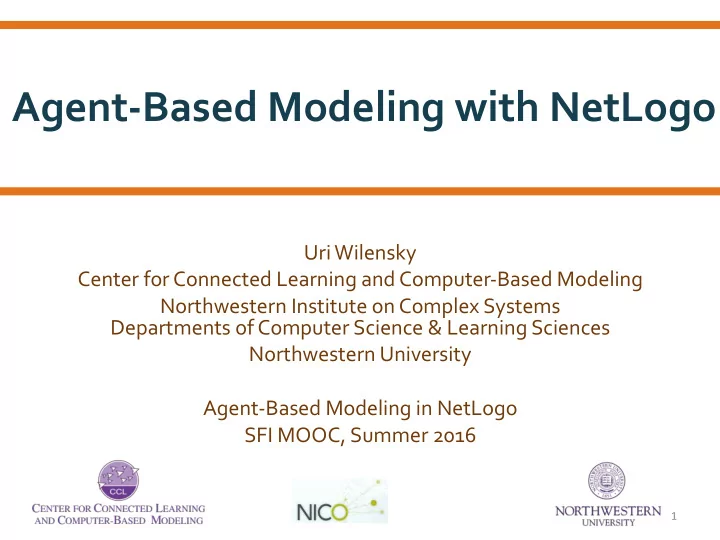

Agent-Based Modeling with NetLogo Uri Wilensky Center for Connected Learning and Computer-Based Modeling Northwestern Institute on Complex Systems Departments of Computer Science & Learning Sciences Northwestern University Agent-Based Modeling in NetLogo SFI MOOC, Summer 2016 1
History: Roman to Hindu-Arabic Europe – at the turn of the first millenium • Before widespread adoption of Hindu-Arabic, very few could do multiplication/division • Scientists recognized superiority immediately • But widespread adoption took a very long time • Was in surreptitious use, but not official 2
Restructurations Structurations -- the encoding of the knowledge in a domain as a function of the representational infrastructure used to express the knowledge Restructurations -- A change from one structuration of a domain to another resulting from a change in representational infrastructure --- Wilensky & Papert 2006;2010
What is important and hard for people today? Similar to numeracy importance for science but difficulties in understanding, today we need to make sense of complex systems yet we find it difficult.
What are Complex Systems? • Systems with a large number of interacting parts, evolving over time • Decentralized decisions vs. centralized control • Emergent global patterns from local interactions and decisions • Examples: ecosystems, economies, immune systems, molecular systems, minds, stock market, democratic government...
Emergent Phenomena • Structure (Rules) at Micro- level leads to pattern at Macro- level • Order without Design • No leader or orchestrator of pattern • Probabilistic, decentralized control -- interactions of distributed “ agents ” • Examples: – Organization of ant colony – Housing patterns in a city – Variations of a population in an ecosystem – Voting patterns – Pressure of a gas – Traffic Jam – The price of a commodity
Emergence is hard • If you know the micro, difficult to predict the macro • If you know the macro, difficult to find the micro structure that generates it
Technology can help • With the aid of new computer-based modeling languages, we can simulate complex patterns and understand more about how they arise in nature and society. • Old way: Simplified ( but advanced mathematical) descriptions of complexity to make analysis possible -- calculate answers • New way: Computers can simulate (thousands of) individual system elements ( “ agents ” ) allowing new, accessible ways to study complex phenomena -- simulate to understand
What is Agent-Based Modeling? An agent is an autonomous individual element endowed with properties and actions, in a computer simulation Agent-Based Modeling (ABM) starts with the idea that the world can be modeled by using a multiplicity of distributed agents, each following simple rules of behavior
What is Agent-Based Modeling (ABM)? • The methodology of ABM encodes the behavior of individual agents in simple rules and then observes and analyzes the results of these agents’ interactions • Used throughout the natural sciences, social sciences, engineering and professions
NetLogo (http://ccl.northwestern.edu/netlogo/) • Multi-agent modeling language (aka agent-based modeling) • 3 core agent types – turtles, patches and links • Thousands of agents behave in parallel • Designed for modeling complex systems: emergent phenomena, evolutionary systems, dynamic networks • Developed at the CCL with NSF support • Many thousands of users across domains and nations (thousands of scientific papers)
Modeling Emergent Patterns in Nature & Society • Fire • Predator/Prey • Segregation
Affordances of ABM • Connects micro- to macro- • Heterogeneity / Individual Differences • Discrete • Stochas<c • Modifiable • Spa<al, Locality • Network
Restructuration of fire spread Equations for fire spread Reynolds Equation Heat Equa<on NetLogo code for fire spread At each tick ask trees [ Each tree if any? neighbors4 with [pcolor = red] Looks NSEW [set pcolor red] If any neighbor on fire ] I get on fire tick
Predator/Prey Restructuration • Lotka Volterra Equations dN 1 /dt = b 1 N 1 - k 1 N 1 N 2 (1) prey dN 2 /dt = k 2 N 1 N 2 - d 2 N 2 (2) predators • At each tick, predators and prey move and lose some energy. If predator lands on prey, it eats it and gains energy. If energy runs out, animal dies. With fixed probability, animals reproduce.
The ABM perspective Large-scale paHerns are the result of: the interac<on and accumula<on of large numbers of smaller components, each with its characteris<c behavior. The secret to understanding much of the world ’ s complexity is to model that complexity as the result of many distributed individuals (agents) following a few simple rules. 16
Dor Abrahamson (Berkeley) Center for Connected Learning Eytan Bakshy (Facebook) Paulo Blikstein (Stanford) & Computer-Based Modeling Corey Brady (Vanderbilt) Damon Centola (Penn) Bryan Head (Northwestern) Arthur Hjorth (Northwestern) Louis Gomez (USC) Robert Grider (Northwestern) Nathan Holbert (Columbia) Mike Horn (Northwestern) Abby Jacobs (Colorado) Ken Kahn (Oxford) Sharona Levy (Haifa) Spiro Maroulis (ASU) Seymour Papert (MIT) Pra<m Sengupta (Calgary) Forrest Stonedahl (Augustana) Seth Tisue (Northwestern) Bill Rand (Maryland) Mitch Resnick (MIT) Adi< Wagh (Tu_s) David Weintrop (Northwestern) ccl.northwestern.edu Michelle Wilkerson (UC Berkeley) Chris<ne Yang (London)
Contact Send mail to mailing lists: • Feedback on NetLogo: feedback@ccl.northwestern.edu • Bugs in NetLogo: bugs@ccl.northwestern.edu • Cita<ons for your published work that uses NetLogo: netlogo-refs@ccl.northwestern.edu 18
Recommend
More recommend